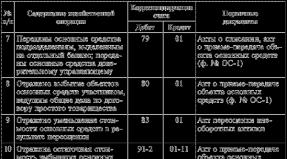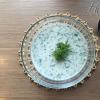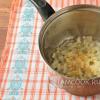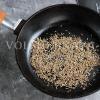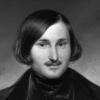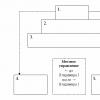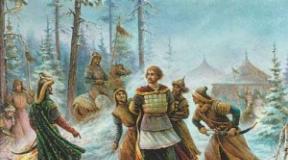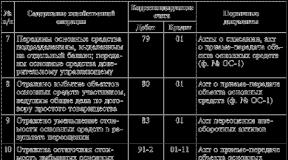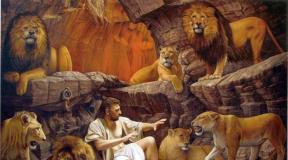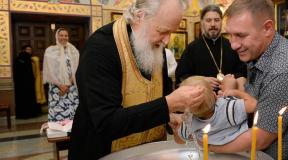His activities were exceptional. Formation of the Old Russian state. Working with chronology
ALL-RUSSIAN OLYMPIAD FOR SCHOOLCHILDREN
ACCORDING TO HISTORY. MUNICIPAL STAGE. 7TH GRADE.
TEST.
When completing the tasks of this part, for each task, choose the answer that, in your opinion, is correct. (For each correct answer 1 point).
1. The following dates back to the 10th century:
Baptism of Rus';
calling of the Varangians;
writing “The Tale of Bygone Years”;
Congress of Princes in Lyubech.
2. The first prince to subjugate most of the East Slavic tribes was
Rurik;
Svyatoslav;
Oleg;
Igor.
3. Polyudye was called (as, axis):
national assembly among the ancient Slavs;
the Grand Duke's tour of the subordinate tribes for the purpose of collecting tribute;
the work of dependent peasants on the feudal lord's farm;
gathering the people's militia to organize resistance to the nomads.
4. According to chronicles, the uprising of the Drevlyans in 945 was caused by:
inter-tribal strife between the Drevlyans and the Ilmen Slovenians;
an attempt by the Kyiv prince to take tribute from the Drevlyans a second time;
the reluctance of the Drevlyans to accept Christianity;
the forced recruitment of the Drevlyans into the squad of Prince Vladimir.
5. Read an excerpt from an essay by a twentieth-century historian and indicate who is being discussed.
“Under him, as the chronicler says, “the Christian faith began to multiply and expand.” Summoning craftsmen from Byzantium, he built churches (of which the most famous was the Cathedral of St. Sophia in Kyiv), founded monasteries, continued the organization of church administration and contributed to the spread and strengthening of Christianity within the vast borders of his state.”
Vladimir Monomakh;
Vladimir Saint;
Svyatoslav Igorevich;
Yaroslav the Wise.
9th century;
X century;
XI century;
XII century.
7. In what war were the Russians forced to retreat with honor after a stubborn defense of the city, but their leader died while returning from the campaign?
the war of Prince Svyatoslav with Byzantium;
Prince Igor's campaign against Constantinople;
the defeat of the Khazar Kaganate by Prince Svyatoslav;
campaign of Vladimir Monomakh against the Polovtsians.
8. What is the name of the oldest part of “Russian Truth”?
"Russian Law";
"The Truth of St. Vladimir";
“The Truth of Yaroslav”;
"The Charter of Vladimir Monomakh".
9. Which of the following concepts is associated with the pagan beliefs of the Slavs?
"corvee";
"rope";
"patrimony";
"temple".
10. The Baptism of Rus' led to...
the rapid disappearance of all traces of pagan beliefs;
subordination to the princely power of the Orthodox Church;
the transformation of Rus' into a state dependent on Byzantium;
the growth of the international authority of the Old Russian state.
11. Read an excerpt from a historian’s essayXIXcentury and indicate whose reign the author characterizes.
“His activities were of exceptional importance: he created a large state from disunited cities and tribes, brought the Slavs out of submission to the Khazars and, through treaties, established correct trade relations between Rus' and Byzantium; in a word, he was the creator of Russian-Slavic independence and strength.”
Rurik;
Oleg;
Igor;
Svyatoslav.
Varangians;
Pechenegs;
Polovtsy;
Khazars
Vladimir Monomakh;
Hilarion;
Nestor;
Nikon.
14. According to the chronicle, Prince Vladimir was baptized in the city...
Kyiv;
Constantinople;
Korsun;
Novgorod.
15. After baptism, the head of the Russian church became...
Grand Duke of Kyiv;
archbishop;
Metropolitan;
patriarch.
16. The first Russian saints are
Askold and Dir;
Boris and Gleb;
Vladimir Saint and Anna;
Cyril and Methodius.
17. As a result of Prince Oleg’s campaign against Constantinople...
a trade agreement beneficial for Rus' was concluded;
Byzantium ceded Danube Bulgaria to Rus';
the prince and his squad were baptized;
the capital of Byzantium was plundered.
A18. Which of the following is part of the process of formation of the feudal system?
A) the emergence of corvée and quitrent;
B) the emergence of purchases and rank-and-file employees
B) the appearance of the first chronicles
D) distribution of lands by the Grand Duke and their transformation into estates
E) decorating temples with mosaics and frescoes
Please indicate the correct answer.
A19. Read an excerpt from “The Tale of Bygone Years” and indicate what it is about.
“Olga went to Novgorod and established graveyards and tributes along Msta, and along Luga - dues and tributes, and her traps were preserved throughout the land, and there are testimonies about her, and her places and graveyards, and her sleigh stands in Pskov to this day, and along the Dnieper there are places for catching birds, and along the Desna...”
tax reform;
the conquest of the rebel tribes;
distribution of estates;
preparation for baptism.
20. Read the passage and indicate under which ruler(s) the document from which the passage is taken was drawn up.
“To kill a husband’s husband, to take revenge on a brother’s brother, or a father’s son, or a son’s father, or a brother’s brother, or a son’s sister; If there is no one seeking revenge, then 40 hryvnia for the head.”
under Vladimir the Saint;
under Yaroslav the Wise;
under Yaroslavich;
under Vladimir Monomakh.
21. Among the management reforms carried out by VladimirI, applies...
using his sons as viceroys;
granting Varangians privileges in Russian service;
the creation of a senior squad as a council under the prince;
strengthening the role of the evening.
22. Vladimir Monomakh ruled in...
1019-1054;
1054-1113;
1113-1125;
1125-1132
24. For Vladimir’s foreign policyIwas characterized by the desire
get rid of paying tribute to the Varangians;
secure Russian lands from Pecheneg raids;
subordinate Byzantium to the Old Russian state;
destroy the Khazar Khaganate.
Exercise 1. Choose 1 correct answer in each task (2 points for each correct answer).
1.1. Read the passage and identify the work of which it is a fragment.
“Children, listen to the commandment of the Lord: love your father and mother and obey them,
and obey them according to God in everything, and honor their old age, and their weakness and all sorrow from
Place your whole soul upon yourself, and it will be good for you, and you will live long on earth..
If anyone slander or insults his parents, or curses them, or scolds them, he
sinful before God and cursed by people and parents.”
1) "Walking beyond the three seas"
2) "Speaker of Hours"
3) "Zadonshchina"
4) "Domostroy"
1.2.
Read an excerpt from the source and identify the event it relates to.
“We don’t want for the Grand Duke of Moscow, we don’t want to be called his patrimony, we are free people, we don’t want to suffer insults from Moscow, we want for the King of Poland and Grand Duke of Lithuania Casimir - this is what the boyars and their supporters shouted at the assembly.”
1) annexation of the Ryazan principality to Moscow
3) Ermak’s campaign
2) annexation of Novgorod to Moscow
4) siege of Pskov by the troops of Stefan Batory
1.3.
Indicate the name of the patriarch who condemned the Polish intervention
1) Philip
2) Hilarion
4) Hermogenes
1.4.
One of the consequences of the internal policy of Tsar Ivan the Terrible is
1) establishment of the patriarchate
2) the beginning of the formation of an estate-absolute monarchy
3) the increasing role of zemstvo councils
4) creation of a regular army based on conscription
Task 2. Choose several correct answers in each task
(2 points for each correct question):
2.1. Indicate Russian statesmen during the reign of Alexei Mikhailovich
1. A.L. Ordin-Nashchokin
2. A.F. Adashev
3. boyar B.I. Morozov
4. Prince A.M. Kurbsky
5. Prince V.V. Golitsyn
2.2.
Select from the list of events relating to the 11th century.
1) creation of “Pravda” by the Yaroslavichs
2) congress of princes in Lyubech
3) Nestor’s creation of “The Tale of Bygone Years”
4) conclusion of the first written agreement with Byzantium
5) creation of the first schools at churches and monasteries
6) foundation of the princely residence in Bogolyubovo
2.3.
What events and phenomena are associated with the reign of Ivan the Terrible
1) creation of the Streltsy army
2) liquidation of the veche system in Novgorod
3) holding the Stoglavy Council
4) the introduction of an all-Russian system of collecting tribute from subject tribes
5) limitation of localism
6) introduction of a unified norm for the transfer of peasants from one owner to another
Task 3.
What unites the concepts, events, names that form each of the presented series? Give a short answer (2 points for each question)
3.1. “The Tale of the Ruin of Ryazan by Batu”, “The Tale of the Destruction of the Russian Land”, “The Tale of Shchelkan”
3.2. Dmitry Shemyaka, Vasily Temny, Vasily Kosoy
3.3.
Prince Kurbsky, nobleman Adashev, priest Sylvester
Task 4.
Restore the chronological sequence of events (2 points for each correctly indicated number):
1. Truce of Deulin
2. Smolensk War
3. Azov seat
4. Battle of Molodi
5. Pereyaslavskaya Rada
6. World of Kardis
Task 5.
Make matches. Write down the selected numbers in the table under the corresponding letters. (1 point for each correct number):
5.1. Match the event and date.
a) Abolition of localism 1) 1471
b) Burning of Moscow by Tokhtamysh 2) 1612
c) Convening of the first Zemsky Sobor 3) 1382
d) Battle on the river. Shelon 4) 1549
e) Liberation of Moscow from the Poles 5) 1682
5.2. Match the ruler and his contemporary:
a) Ivan the Terrible 1) Prince Kurbsky
b) Vasily Shuisky 2) Filaret
c) Vladimir the Holy 3) Boris and Gleb
d) Yaroslav the Wise 4) Metropolitan Hilarion
Task 6.
TO Which of the listed historical figures were in Tver. (1 point for the correct answer)
1.Peter the Great
2.Catherine the Great
3.Marina Mnishek
4. Stepan Razin
5.Emelyan Pugachev
6.Alexander I
7.Nicholas I
Task 7. (1 point for the correct answer)
Working with sources
Determine what events are discussed in the passages from The Tale of Bygone Years. Fill the table.
1. “And he commanded his soldiers to make wheels and put ships on wheels. And with a fair wind they raised the sails and walked across the field to the city. The Greeks, seeing this, were frightened and said through the ambassadors: “Do not destroy the city, we will give you whatever tribute you want.” And he stopped the soldiers, and brought him food and wine, but did not accept it, since it was poisoned... And he ordered tribute to be given for two thousand ships: twelve hryvnias per person, and there were forty men in each ship.”
2. “... He sent his squad home, and he himself returned with a small part of the squad, wanting more wealth. The Drevlyans, hearing that he was coming again, held a council with their prince Mal: “If a wolf gets into the habit of the sheep, he will carry out the whole flock until they kill him; so will this one: if we don’t kill him, he will destroy us all.” And they sent to him, saying: “Why are you going again? You’ve already taken all the tribute.” And I didn’t listen to them...”
3. “And they sent with the words: “You, prince, are looking for someone else’s land and taking care of it, but you left your own, And we were almost taken by the Pechenegs and your mother and your children. If you don’t come and protect us, they will take us.” After all, don’t you feel sorry for your fatherland, your old mother, your children?”
4. “And he placed idols on the hill behind the tower courtyard: a wooden Perun with a silver head and a golden mustache, then Khors, Dazhbog, Stribog, Simargl and Mokosh. And they made sacrifices to them, calling them gods, and brought their sons and daughters to them, and these sacrifices went to the demons, and they desecrated the earth with their sacrifices. And the Russian land and that hill were defiled with blood.”
5. “...He ordered the idols to be overturned - some to be chopped up and others to be burned. Peruna ordered to tie the horse to the tail and drag it... to the Stream and ordered twelve men to beat him with rods. This was done not because the tree feels anything, but to mock the demon who deceived people in this image - so that he would take retribution from people.”
6. “His mother taught him to be baptized, but he did not think to listen to it; but if someone was going to be baptized, he did not forbid, but only mocked, saying: “How can I alone accept a different faith? And my squad will mock.” She told him: “If you are baptized, then everyone will do the same.”
7. “And a terrible miracle was seen. The Russians, seeing the flames, threw themselves into the sea water, trying to escape - and so the rest of them returned home. And having come to their land, they told - each to their own - about what had happened and about the fire of the rooks. “It’s as if the Greeks had lightning from heaven,” they said, “and, releasing it, they burned us; that’s why they didn’t defeat them.”
8. “They drove the Varangians overseas, and did not give them tribute, and began to control themselves, and there was no truth among them, and generation after generation arose, and they had strife, and began to fight with each other. And they said to themselves: “Let’s look for a prince who would rule over us and judge us by right.” And they went overseas to the Varangians...”
9. “When he grew up and matured, he began to gather many brave warriors, and was fast, like a pardus (leopard), and fought a lot. On campaigns, he did not carry carts or cauldrons with him, did not cook meat, but thinly sliced horse meat, or animal meat, or beef and fried it over coals, and ate it like that; He did not have a tent, but slept on a sweatcloth with a saddle in his head - all his other warriors were the same. And he sent them to other lands with the words: “I want to go against you.” And he went to the Oka River and the Volga, and met the Vyatichi...”
10. “And there were countless Pechenegs. He set out from the city and formed a squad, and placed the Varangians in the middle, and on the right side - the Kievites, and on the left wing - the Novgorodians; and stood before the hail. The Pechenegs launched an attack and fought in the place where St. Sophia, the Russian metropolis, now stands: there was then a field outside the city. And there was a cruel slaughter... And the Pechenegs fled in all directions, and did not know where to run; some, running away, drowned in Setomli, others in other rivers, and the rest of them are running somewhere to this day.”
Read each task carefully and the suggested answer options, if any. Answer only after you understand the question and have considered all possible answers.
Complete the tasks in the order in which they are given. If a task is difficult for you, skip it. You can return to missed tasks if you have time.
One or more points are given for completing tasks of varying complexity. The points you receive for completed tasks are summed up. Try to complete as many tasks as possible and score the most points.
When completing the tasks of this part, for each task, choose the answer that, in your opinion, is correct.
A1. By the 10th century:
1) baptism of Rus';
2) the calling of the Varangians;
3) writing “The Tale of Bygone Years”;
4) congress of princes in Lyubech.
A2. The first prince to subjugate most of the East Slavic tribes was
2) Svyatoslav;
A3. Polyudye was called (as, axis):
1) popular assembly among the ancient Slavs;
2) the Grand Duke’s tour of the subordinate tribes for the purpose of collecting tribute;
3) the work of dependent peasants on the feudal lord’s farm;
4) gathering of the people's militia to organize resistance to the nomads.
A4. According to chronicles, the uprising of the Drevlyans in 945 was caused by:
1) inter-tribal strife between the Drevlyans and the Ilmen Slovenians;
2) an attempt by the Kyiv prince to take tribute from the Drevlyans a second time;
3) the reluctance of the Drevlyans to accept Christianity;
4) forcible recruitment of Drevlyans into the squad of Prince Vladimir.
A5. Read an excerpt from an essay by a twentieth-century historian and indicate who is being discussed.
“Under him, as the chronicler says, “the Christian faith began to multiply and expand.” Summoning craftsmen from Byzantium, he built churches (of which the most famous was the Cathedral of St. Sophia in Kyiv), founded monasteries, continued the organization of church administration and contributed to the spread and strengthening of Christianity within the vast borders of his state.”
1) Vladimir Monomakh;
2) Vladimir the Holy;
3) Svyatoslav Igorevich;
4) Yaroslav the Wise.
A6. In what century did all these events take place - the murder of Boris and Gleb; the final defeat of the Pechenegs; the beginning of the Polovtsian invasions of Russian lands?
A7. In what war were the Russians forced to retreat with honor after a stubborn defense of the city, but their leader died while returning from the campaign?
1) the war of Prince Svyatoslav with Byzantium in Danube Bulgaria;
2) Prince Igor’s campaign against Constantinople;
3) the defeat of the Khazar Kaganate by Prince Svyatoslav;
4) the campaign of Vladimir Monomakh against the Polovtsians.
A8. What is the name of the oldest part of “Russian Truth”?
1) “Russian Law”;
2) “The Truth of St. Vladimir”;
3) “The Truth of Yaroslav”;
4) “The Charter of Vladimir Monomakh.”
A9. Which of the following concepts is associated with the pagan beliefs of the Slavs?
1) “corvée”;
2) “rope”;
3) “patrimony”;
4) “temple”.
A10. The Baptism of Rus' led to...
1) the rapid disappearance of all traces of pagan beliefs;
2) subordination to the princely power of the Orthodox Church;
3) the transformation of Rus' into a state dependent on Byzantium;
A11. Read an excerpt from an essay by a 19th-century historian and indicate whose reign the author is describing.
“His activities were of exceptional importance: he created a large state from disunited cities and tribes, brought the Slavs out of submission to the Khazars and, through treaties, established correct trade relations between Rus' and Byzantium; in a word, he was the creator of Russian-Slavic independence and strength.”
4) Svyatoslav.
A12. Prince Vladimir the Holy created a system of defensive fortifications against raids...
1) Varangians;
2) Pechenegs;
1) Vladimir Monomakh;
2) Hilarion;
3) Nestor;
A14. According to the chronicle, Prince Vladimir was baptized in the city...
2) Constantinople;
3) Korsun;
4) Novgorod.
A15. After baptism, the head of the Russian church became...
1) Grand Duke of Kyiv;
2) archbishop;
3) metropolitan;
4) patriarch.
A16. The first Russian saints are
1) Askold and Dir;
2) Boris and Gleb;
3) Vladimir Saint and Anna;
4) Cyril and Methodius.
A17. As a result of Prince Oleg's campaign against Constantinople...
1) a trade agreement beneficial for Rus' was concluded;
2) Byzantium ceded Danube Bulgaria to Rus';
3) the prince and his squad were baptized;
4) the capital of Byzantium was plundered.
A18. Which of the following is part of the process of formation of the feudal system?
A) the emergence of corvée and quitrent;
B) the emergence of purchases and rank-and-file employees
B) the appearance of the first chronicles
D) distribution of lands by the Grand Duke and their transformation into estates
E) decorating temples with mosaics and frescoes
Please indicate the correct answer.
A19. Read an excerpt from “The Tale of Bygone Years” and indicate what it is about.
“Olga went to Novgorod and established graveyards and tributes along Msta, and along Luga - dues and tributes, and her traps were preserved throughout the land, and there are testimonies about her, and her places and graveyards, and her sleigh stands in Pskov to this day, and along the Dnieper there are places for catching birds, and along the Desna...”
1) tax reform;
2) the conquest of the rebel tribes;
3) distribution of estates;
4) preparation for baptism.
A20. Read the passage and indicate under which ruler(s) the document from which the passage is taken was drawn up.
“To kill a husband’s husband, to take revenge on a brother’s brother, or a father’s son, or a son’s father, or a brother’s brother, or a son’s sister; If there is no one seeking revenge, then 40 hryvnia per head.”
1) under St. Vladimir;
2) under Yaroslav the Wise;
3) under Yaroslavich;
4) under Vladimir Monomakh.
A21. During the war with Byzantium, Svyatoslav...
1) subjugated the Vyatichi;
2) personally met with the emperor;
3) nailed the shield to the gates of Constantinople;
4) was baptized.
A22. Among the changes in management carried out by Vladimir I are...
1) using their sons as governors;
2) granting the Varangians privileges in Russian service;
3) the creation of a senior squad as a council under the prince;
4) strengthening the role of the veche.
A23. Vladimir Monomakh ruled in...
1) 1019-1054;
2) 1054-1113;
3) 1113-1125;
4) 1125-1132
1) “purchases”;
2) “patrimonial people”;
3) “magi”;
4) all of the above.
A25. One of the main goods exported from Ancient Rus' was...
1) wood;
A26. The foreign policy of Vladimir I was characterized by the desire
1) get rid of paying tribute to the Varangians;
2) secure Russian lands from Pecheneg raids;
3) subordinate Byzantium to the Old Russian state;
4) destroy the Khazar Khaganate.
A27. What was one of the reasons for the formation of the Old Russian state?
1) the need to establish trade with Byzantium;
2) inviting the Varangians to serve the Slavic tribes;
3) the spread of Christianity;
4) strengthening the tribal system.
A28. Read an excerpt from “The Tale of Bygone Years” and indicate what followed the events described.
“That year the squad said to Igor: “The youths of Sveneld are dressed in weapons and clothes, and we are naked. The prince will go with us for tribute, and you will get it for yourself, and for us.” And Igor listened to them - he went to the Drevlyans for tribute...”
1) the Drevlyans turned to the Khazars for help;
2) Igor’s squad killed the Drevlyan elders;
3) the land of the Drevlyans was annexed to Ancient Rus';
4) Igor was killed by the Drevlyans.
A29. Read an excerpt from the document, choose a statement related to it.
“As for ar-Rusiya, it is located on an island surrounded by a lake... They have a king called the Kagan of the Rus. They attack the Slavs, approach them on ships, disembark, take them prisoner, take them to Khazaria and Bulgaria and sell them there. They have no arable land, but feed only on what they bring from the land of the Slavs."
1) has a purely fantastic character;
2) dates back to the 11th century;
3) confirms the arguments of supporters of the Norman theory;
4) talks about the struggle of the Slavs with the Khazar Khaganate.
A30. St. Sophia Cathedrals were built in
2) Novgorod;
3) Polotsk;
4) all the cities listed above.
A31. Read an excerpt from a work by a Byzantine historian and indicate when what it describes could have happened.
“The winter and harsh way of life of those same dews is like this. When the month of November comes, the archons immediately leave Kyiv with all the Ros and go to... Slavinia of the Vervians, Druguvites, Krivichi, Severii and other Slavs, who are tributaries of the Ros. Feeding there throughout the winter, they return to Kyiv again, starting in April, when the ice on the Dnieper River melts.”
1) under Rurik;
2) under Oleg and Igor;
3) under Svyatoslav;
4) under Vladimir.
A32. In what year did the unification of Kyiv and Novgorod take place within one state?
A33. Which of the named persons Not was he a descendant of Rurik?
1) Vladimir Monomakh;
2) Vladimir the Holy;
3) Oleg the Prophet;
4) Svyatoslav Igorevich.
A34. The concepts of “filigree” and “grain” are associated with (o)...
1) the formation of ancient Russian statehood;
2) the development of crafts in Ancient Rus';
3) the formation of the feudal system;
4) the spread of Christianity.
A35. An obligatory element of the patrimony was (o, a)
1) military squad for border protection;
2) the use of slave labor;
3) the presence of fishing grounds and forests;
4) transmission by inheritance.
A36. The result of Vladimir Monomakh’s accession to the Kyiv throne was
1) temporary cessation of princely civil strife;
2) the final defeat of the Polovtsians;
3) the subordination of the Drevlyans to the power of the Kyiv prince;
4) turning Kyiv into the capital of the state.
A37. Which tribes belong to the eastern branch of the Slavs?
A) Vyatichi
B) Slovenian Ilmenskie
B) Slovenes
D) Poles
D) clearing
E) muroma
Please indicate the correct answer.
A38. Read an excerpt from a Western European chronicle and explain why the head of the Old Russian state is called so unusually in it.
“King Henry sent... to a certain to the king in the Greek regions so that he would give him his daughter as a wife. He sent them back to France with great gifts and their daughter.”
1) Rus' was then dependent on Byzantium;
2) Rus' adopted Eastern Christianity from Byzantium;
3) Rus' traded a lot with Byzantium;
4) many people from Byzantium lived in Rus'.
A39. The calling of the Varangians, according to the chronicle story, is connected with(o)
1) the desire to get rid of the power of the Khazars;
2) the inability of the Slavs to independently defend themselves;
3) strife between Novgorodians;
4) fear of the Varangian invasion.
A40. One of the main problems solved by the Yaroslavichs was
1) the fight against the metropolitans’ claims to supreme power;
2) organizing the fight against the Polovtsians;
3) preparation for the invasion of Byzantium;
4) subjugation of all East Slavic tribes.
Tasks B1 – B10 require an answer in the form of one or two words or a sequence of letters.
B1. Place the following events in chronological order. Write down the letters that represent the events in the correct sequence. For example: BVAG.
A) baptism of Novgorodians
B) baptism of Vladimir I
B) baptism of Kievites
D) campaign of Vladimir I to Korsun
B2. Establish a correspondence between the neighboring countries of Rus' and the religions that dominated them in the 10th century. When writing down the answer save subsequence first column. Write down the answer DO NOT make gaps or use commas. For example: 1В2А3Б4Г.
B3. Read an excerpt from the work of historian N.M. Karamzin and name the Old Russian prince to whom this characteristic applies.
“Thus died this Alexander of our ancient History, who fought so courageously both with enemies and with adversity, was sometimes defeated, but in the very misfortune he amazed the victor with his generosity, equaled the harsh military life with the Heroes of the Songsinger Homer and, patiently enduring the ferocity of bad weather , exhausting labor and everything terrible for bliss, showed Russian soldiers how they could defeat their enemies at all times. But..., the example of great Commanders, is not an example of a great Sovereign, for he respected the glory of victories more than the state good, and, with his character, captivating the imagination of the Poet-Creator, he deserves the reproach of the Historian.”
B4. Establish a correspondence between the princes of Ancient Rus' and the peoples and states to which these princes inflicted major military defeats, which had important consequences for the further course of events. When recording a response save subsequence first column. Write down the answer DO NOT make gaps or use commas. For example: 1В2А3Б4Г.
B5. Read an excerpt from “Russkaya Pravda”, name which social structure this article assigned the responsibility to.
“If someone kills a prince’s husband as a robber, and they are not looking for the killer, then a vira (fine) for him in the amount of 80 hryvnia will be paid to the one... on whose land the murdered person is found; in case of murder of a lyudin (commoner), pay the viru (prince) 40 hryvnia.”
B6. Read an excerpt from the work of historian S.M. Solovyov and write who you are talking about.
He is presented in the chronicles as “an inactive prince, an unbrave leader. He does not go for tribute to previously subjugated tribes, does not conquer new ones, his squad is poor and timid, like him: with great forces they return back from the Greek campaign without a fight. But to these character traits in the legend another one is added - selfishness, unworthy, according to the concepts of that time, of a good leader of the squad, who shared everything with it.
B7. Establish a correspondence between the name of the people (tribe, union of tribes) and the area of their residence. When recording a response save subsequence first column. Write down the answer DO NOT make gaps or use commas. For example: 1В2А3Б4Д.
B8. Read an excerpt from “The Tale of Bygone Years” and write the name of the place where the event described occurred.
“We gathered... to establish peace, and said to each other: “Why are we destroying the Russian land, arranging strife among ourselves? But the Polovtsians are fighting our land separately and are glad that wars are going on between us. Let us from now on unite with one heart and guard the Russian land, and let everyone own his fatherland..." And on that they kissed the cross."
B9. Establish a correspondence between the rulers of Ancient Rus' and their contribution to the formation of the Old Russian state. When recording a response save subsequence first column. Write down the answer DO NOT make gaps or use commas. For example: 1В2Д3Б4Г.
B10. Read an excerpt from an article by a modern historian and write the name of the person in question.
“At the age of sixteen he became the prince of Chernigov, one of the most ancient and powerful cities in Rus', then succeeded his father not at the Pereyaslav “table”, taking on his shoulders the entire burden of defending the southern border, but in his later life, at the age of sixty, at the zenith of military glory, was called to the capital Kyiv, became the Grand Duke. But wherever he reigned, he remained a warrior for the Russian land, a tireless warrior.”
He was married to the English princess Gita, daughter of King Harold, who died in the Battle of Hastings with the Norman conquerors. Their son, Yuri Dolgoruky, will be the founder of the dynasty of Vladimir-Suzdal princes.”
Read an excerpt from a historical source and briefly answer questions C1 – C3. Answers involve the use of information from the source and the application of historical knowledge and skills.
From The Tale of Bygone Years.
“And the noble prince Mikhail, whose name was Svyatopolk, died on the 16th day of April outside Vyshgorod, they brought him in a boat to Kyiv, and brought his body into proper shape, and laid it on a sleigh. And the boyars and his entire squad cried for him; After singing the funeral songs over him, he was buried in the Church of St. Michael, which he himself built. His princess (wife) generously divided his wealth among monasteries, priests, and the poor, so that people were amazed, for no one could create such generous alms. After that, on the tenth day, the people of Kiev held a council and sent to Vladimir, saying: “Go, prince, to your father’s and grandfather’s table.” Hearing this, Vladimir cried a lot and did not go (to Kyiv), grieving for his brother. The Kievans plundered the courtyard of Putyata Tysyatsky, attacked the Jews, and plundered their property. And the Kyivians again sent to Vladimir, saying: “Go, prince, to Kyiv; if you don’t go, then know that a lot of evil will happen, not only the Putyatin yard or the sotskys, but also the Jews will be robbed, and they will also attack your daughter-in-law, and against the boyars, and against the monasteries, and you will have to answer, prince, if the monasteries are also plundered." Hearing this, Vladimir went to Kyiv.”
C1. What events are described in this passage? Name the time when they occurred.
C2. Why did riots occur in Kyiv? In what meanings does the chronicler use the word “Kievians”?
C3. Why did Prince Vladimir at first refuse to become the prince of Kyiv, but then agreed?
Tasks C4-C7 involve different types of activities: presentation of a generalized description of historical events and phenomena (C4), comparison (C5), analysis of the historical situation (C6), consideration of historical versions and assessments (C7). As you complete these tasks, pay attention to the wording of each question.
C4. Indicate the main results of the foreign and domestic political activities of Prince Oleg (the Prophet).
C5. Compare the biographies and political activities of Prince Igor and his son Svyatoslav. Find similarities and differences.
Note. Write your answer in table form. At the same time, in the second part of the table, both differences in comparable characteristics and those features that were inherent only in one of the objects should be given.
C6. Consider the historical situation (the baptism of Rus') and answer the questions.
Why did Prince Vladimir choose precisely in favor of adopting Eastern Christianity from Byzantium? Why did Vladimir start a war with the state from which he decided to accept a new faith?
C7. Information from historical sources about the relationship between the Slavs and the Varangians gives rise to different assessments by historians. What assessments do you know, what arguments are given in the dispute? Which assessment do you find more convincing? Provide provisions and facts that support your chosen point of view.
Training on the topic “Ancient Rus'”
1. Working with chronology
Fill the table. Determine the sequence of events.
Revolt of the Drevlyans | ||
Death of Svyatoslav | ||
Baptism of Rus' | ||
Lyubech Congress | ||
Calling of the Varangians | ||
Defeat of the Khazar Khaganate | ||
___→___→___→___→___→___→___→___→___→___→___→___
2. Working with personalities
Fill the table. (The right column indicates the minimum number of facts that you need to know.)
When did you act? | Who is(are)? | ||
Askold and Dir | |||
Bayer, Miller and Schlozer | |||
Boris and Gleb | |||
Vladimir I | |||
Vladimir II Monomakh | |||
Cyril and Methodius | |||
Svyatopolk the Accursed | |||
Svyatoslav | |||
Yaroslav the Wise | |||
Yaroslavichy |
3. Working with the circuit
1. Fill out the pedigree table. Emphasize those princes who occupied the Kiev grand-ducal throne.
2. Fill out the management diagram of the Old Russian state.

4. Working with the map
Find on the map:
Volga Bulgaria;
city of Dorostol;
the city of Itil (the capital of the Khazar Kaganate);
city of Kyiv;
city of Constantinople;
city of Korsun;
city of Novgorod;
borders of the DRG under Vladimir I
borders of the DRG under Prince Igor and Princess Olga;
borders of the Democratic Republic of Germany under Prince Oleg;
borders of the DRG under Yaroslav the Wise;
Danube Bulgaria;
the most likely ancestral home of the Slavs;
area of settlement of the Varangians;
Vyatichi settlement area;
area of settlement of the Drevlyans;
area of settlement of the Pechenegs in the 10th – early 11th centuries;
area of settlement of the Polovtsians in the second half of the 11th - early 12th centuries;
clearing settlement area;
area of settlement of the Ilmen Slovenians.
5. Working with concepts
Define the concepts.
Corvee __________________________________________________.
Rope _____________________________________________________.
Magus _____________________________________________________.
Patrimony ___________________________________________________.
Purchase _____________________________________________________.
Grain _____________________________________________________.
Idol ______________________________________________________________.
Temple ___________________________________________________.
Metropolitan _______________________________________________.
Mosaic ___________________________________________________.
Quiet _____________________________________________________.
Ryadovich ___________________________________________________.
Scan _____________________________________________________.
Fresco _____________________________________________________.
Serf _____________________________________________________.
6. Working with sources
Determine what events are discussed in the passages from The Tale of Bygone Years. Fill the table.
1. “And he commanded his soldiers to make wheels and put ships on wheels. And with a fair wind they raised the sails and walked across the field to the city. The Greeks, seeing this, were frightened and said through the ambassadors: “Do not destroy the city, we will give you whatever tribute you want.” And he stopped the soldiers, and brought him food and wine, but did not accept it, since it was poisoned... And he ordered tribute to be given for two thousand ships: twelve hryvnias per person, and there were forty men in each ship.”
2. “... He sent his squad home, and he himself returned with a small part of the squad, wanting more wealth. The Drevlyans, having heard that he was coming again, held a council with their prince Mal: “If a wolf gets into the habit of the sheep, he will carry out the entire flock until they kill him; so is this one: if we don’t kill him, he will destroy us all.” And they sent to him, saying: “Why are you going again? I’ve already taken all the tribute.” And I didn’t listen to them...”
3. “And they sent with the words: “You, prince, are looking for someone else’s land and taking care of it, but you left your own, And we were almost taken by the Pechenegs and your mother and your children. If you don’t come and protect us, they will take us. Don’t you feel sorry for your fatherland, your old mother, your children?”
4. “And he placed idols on the hill behind the tower courtyard: a wooden Perun with a silver head and a golden mustache, then Khors, Dazhbog, Stribog, Simargl and Mokosh. And they made sacrifices to them, calling them gods, and brought their sons and daughters to them, and these sacrifices went to the demons, and they desecrated the earth with their sacrifices. And the Russian land and that hill were defiled with blood.”
5. “...He ordered the idols to be overturned - some to be chopped up and others to be burned. Peruna ordered to tie the horse to the tail and drag it... to the Stream and ordered twelve men to beat him with rods. This was done not because the tree feels anything, but to mock the demon who deceived people in this image - so that he would take retribution from people.”
6. “His mother taught him to be baptized, but he did not think to listen to it; but if someone was going to be baptized, he did not forbid, but only mocked, saying: “How can I alone accept a different faith? And my squad will mock.” She told him: “If you are baptized, then everyone will do the same.”
7. “And a terrible miracle was seen. The Russians, seeing the flames, threw themselves into the sea water, trying to escape - and so the rest of them returned home. And having come to their land, they told - each to their own - about what had happened and about the fire of the rooks. “It was as if the Greeks had lightning from heaven,” they said, “and, releasing it, they burned us; That’s why they didn’t overcome them.”
8. “They drove the Varangians overseas, and did not give them tribute, and began to control themselves, and there was no truth among them, and generation after generation arose, and they had strife, and began to fight with each other. And they said to themselves: “Let’s look for a prince who would rule over us and judge us by right.” And they went overseas to the Varangians...”
9. “When he grew up and matured, he began to gather many brave warriors, and was fast, like a pardus (leopard), and fought a lot. On campaigns, he did not carry carts or cauldrons with him, did not cook meat, but thinly sliced horse meat, or animal meat, or beef and fried it over coals, and ate it like that; He did not have a tent, but slept on a sweatcloth with a saddle in his head - all his other warriors were the same. And he sent them to other lands with the words: “I want to go against you.” And he went to the Oka River and the Volga, and met the Vyatichi...”
10. “And there were countless Pechenegs. He set out from the city and formed a squad, and placed the Varangians in the middle, and on the right side - the Kievites, and on the left wing - the Novgorodians; and stood before the hail. The Pechenegs launched an attack and fought in the place where St. Sophia, the Russian metropolis, now stands: there was then a field outside the city. And there was a cruel slaughter... And the Pechenegs ran in all directions, and did not know where to run, some, running away, drowned in Setomli, others in other rivers, and the rest of them are running somewhere to this day.”
ANSWERS
Training
1. Working with chronology
Fill out the table (1 - you must indicate the century or decade, 2 - the exact date). Determine the sequence of events.
Revolt of the Drevlyans | ||
The second uprising in Kyiv and the calling of Vladimir Monomakh | ||
Death of Svyatoslav | ||
Baptism of Rus' | ||
Lyubech Congress | ||
Unification of Novgorod and Kyiv within one state | ||
The final collapse of the Old Russian state | ||
Defeat of the Yaroslavichs from the Polovtsians and the uprising in Kyiv | ||
Oleg's campaign against Constantinople | ||
Calling of the Varangians | ||
Defeat of the Khazar Khaganate | ||
Strife among the sons of Vladimir |
10→6→9→1→11→3→4→12→8→5→2→7
2. Working with personalities
When did you act? | Who is(are)? | What did you do? What happened to him? | |
Tue. floor. Hv. | Byzantine princess | 1. Married Vladimir I after baptism |
|
Askold and Dir | Tue. floor. 9th century | rulers of Kyiv | 1. Killed by Prince Oleg during the capture of the city |
Bayer, Miller and Schlozer | XVIII century | scientists, Germans by origin, worked in Russia | 1. Creators of the Norman theory |
Boris and Gleb | beginning of the 11th century | princes, sons of Vladimir I | 1. Killed by Svyatopolk the Accursed 2. The first Russian saints |
Vladimir I | reign: 980-1015 | 1. He won the fight with his brother Yaropolk 2. Made his sons governors 3. Organized the defense of the southern borders from Pecheneg raids 4. Tried to reform paganism 5. Baptized Rus' (988) |
|
Vladimir II Monomakh | years of reign in Kyiv: 1113-1125 | prince, grandson of Yaroslav the Wise, on his mother’s side - grandson of the Byzantine Emperor Constantine Monomakh | 1. Organizer of the joint fight against the Polovtsians 2. Earned fame as a fair ruler, an opponent of civil strife 4. Was invited to the Kiev throne in violation of the established order of succession 5. Added to the “Russian Truth” by regulating the charging of usurious interest |
first floor. X century | Grand Duke of Kyiv, son of Rurik | 1. Leader of the unsuccessful campaign against Byzantium in 941. 2. Leader of the campaign against Byzantium in 944. 3. Killed by the Drevlyans while collecting tribute |
|
XI century | metropolitan | 1. The first Russian by birth metropolitan |
|
Cyril and Methodius | 9th century | educators in Slavic lands | 1. Creators of Slavic writing |
beginning of the 12th century | monk of the Kiev Pechersk Monastery | ||
end of the 9th – beginning of the 10th centuries. | first - the ruler of Novgorod, then - of Kyiv, possibly a relative of Rurik | 1. Captured Kyiv, killing Askold and Dir 2. Subjugated most of the East Slavic tribes 3. Made a very successful campaign against Constantinople in 907 4. Concluded an agreement with Byzantium that was beneficial for the Rus |
|
Igor's wife, ruler of the Democratic Republic of Germany with her young son Svyatoslav | 1. Cruelly took revenge on the Drevlyans for the death of her husband 2. Introduced strict norms for collecting tribute 3. Made a diplomatic trip to Constantinople 4. Received baptism according to the Byzantine rite |
||
9th century | Varangian prince | 1. In 862 he was called to reign in Novgorod |
|
Svyatopolk the Accursed | beginning of the 11th century | prince, son of Vladimir I (possibly Yaropolk) | 1. Seized power in Kyiv after the death of Vladimir I 2. Accused of the murder of Boris and Gleb |
Svyatoslav | Grand Duke of Kyiv, son of Igor | 1. Defeated the Khazar Khaganate 2. Attached Vyatichi to the DRG 3. Fought in Danube Bulgaria, first against the Bulgarians, and then against Byzantium 4. He wanted to move the center of his power to the Danube 5. Retreated after defending Dorostol 6. Killed by the Pechenegs while returning from the Danube |
|
Grand Duke of Kyiv, son of Svyatoslav | 1. Lost the struggle for power to Vladimir I |
||
Yaroslav the Wise | reign: 1019-1054 | Grand Duke of Kiev, son of Vladimir I | 1. With the help of the Varangians, he won the internecine struggle among the sons of Vladimir 2. Inflicted a decisive defeat on the Pechenegs 3. Under him, Ancient Rus' flourished 4. Churches of St. Sophia were built in Kyiv, Novgorod and Polotsk 5. The compilation of “Russian Truth” began 6. Divided the state between his sons 7. Married his daughters to the kings of France, Norway and Hungary |
Yaroslavichy | Tue. floor. XI century | princes, sons of Yaroslav the Wise | 1. Entered into an internecine struggle with each other 2. Were defeated by the Cumans 3. Added and changed “The Truth of Yaroslav” |
3. Working with the circuit
1 . 1 - Oleg; 2 - Rurik; 3 - Igor; 4 - Olga; 5 - Svyatoslav; 6 - Yaropolk; 7 - Oleg; 8 - VladimirI ; 9 - Svyatopolk the Accursed; 10 - Yaroslav the Wise; 11 - Saints Boris and Gleb; 12 - Izyaslav; 13 - Svyatoslav; 14 - Vsevolod; 15 - Svyatopolk; 16 - VladimirII Monomakh.
2 . 1 - Grand Duke of Kyiv; 2 - senior squad; 3 - junior squad; 4 - local princes (independent dynasties); 5 - prince-deputies from the Rurik family (descendants of Vladimir I).
4. Working with concepts
Corvee is a feudal service, which consisted in the obligation of a dependent peasant to work on the farm and in the field of the feudal lord.
Verv is a peasant community among the ancient Slavs.
Magus is a pagan priest among the ancient Slavs.
Votchina is a large land holding with dependent peasants, passed on by inheritance.
Zakup is a dependent peasant who worked for a debt (“kupu”).
Grain is a pattern of small gold or silver grains that are soldered onto a metal plate.
An idol is a sculptural image of a pagan deity.
The temple is a sanctuary among the ancient Slavs, in which sacrifices were made to the gods.
Metropolitan is the head of the Russian Orthodox Church after baptism, appointed by the patriarch.
Mosaic is a picture made of colored glass.
Quirk is a feudal duty of dependent peasants, which consisted of the obligation to give the feudal lord part of the products produced on their plot or the money they earned.
Ryadovich is a dependent peasant who worked under a contract (“row”).
Filigree is a pattern made of gold or silver wire soldered onto a metal base.
Fresco is painting on wet plaster.
Serf - slave.
5. Working with sources
Place and time of the event | Characters | Consequences | |
At the walls of Constantinople (Constantinople), 907 | Prince Oleg and the Byzantines | Byzantium paid a huge tribute and agreed to conclude a treaty beneficial for the Rus |
|
Land of the Drevlyans, 945 | Prince Igor and the Drevlyans | Igor was killed by the Drevlyans, Princess Olga avenged her husband’s death, but established firm standards for collecting tribute |
|
Letter from the people of Kiev to Prince Svyatoslav | Svyatoslav still did not become the defender of his land (although he responded to this particular letter, came and defeated the Pechenegs) |
||
Kyiv, 980 | Prince Vladimir I | The pagan reform was not successful, and a “change of faith” was needed |
|
Kyiv, 988 | Prince Vladimir I | Christianity from Kyiv began to spread throughout Rus' |
|
Kyiv, during the reign of Svyatoslav | Svyatoslav and his mother Princess Olga | Svyatoslav never received baptism |
|
Ancient Rus', 941 | Participants in Prince Igor's campaign | After 3 years, Igor made a new campaign, more successful |
|
Novgorod, 862 | Novgorodians | The calling of the Varangians, the beginning of the Rurik dynasty |
|
Frontiers of Ancient Rus', the reign of Svyatoslav | Prince Svyatoslav | Subjugation of the Vyatichi, other victories |
|
At the walls of Kyiv, during the reign of Yaroslav the Wise | Armies of the Old Russian State and the Pechenegs | The Pecheneg threat was eliminated, but soon the Polovtsy came to the steppe to “replace” the Pechenegs |
6. Working with the historian's judgment
“Episode” – the capture of Kyiv by Prince Oleg in 882. The historian’s views can be characterized as extreme anti-Normanism. His opponents were supporters of the Norman theory, who emphasized the importance of the Varangians in the formation of the Old Russian state and called Prince Oleg its founder.
Part 3
Note. Only brief answers are given here; they may be more detailed. The number of points for each required element of the answer and the total number of points are indicated in parentheses.
C1. Calling of Prince Vladimir Monomakh to the Great reign of Kiev (1) in 1113 (1) ( Total – 2.)
C2. The cause of the unrest was the dissatisfaction of low-income townspeople with debts to moneylenders (1), who, taking advantage of the patronage of the deceased prince, took high interest rates. The chronicler uses the word “Kievans” in two meanings: 1) rebels who plundered the yard of the thousand and the houses of the moneylenders (1); 2) noble townspeople who called on Prince Vladimir to calm the city (1). ( Total – 3.)
C3. Vladimir Monomakh did not have rights to the Kiev throne in accordance with the order of succession established by his grandfather Yaroslav the Wise, and did not want to violate it (1). However, the danger of growing unrest forced him to agree (1). ( Total – 2.)
C4. In domestic politics, Prince Oleg subjugated most of the East Slavic tribes (1) and created a state centered in Kyiv (1). However, there were no laws regulating this subordination, which created the ground for conflicts in the near future (1). In foreign policy, the main achievement of Prince Oleg was the successful campaign against Byzantium, which gave the Old Russian state a profitable trade agreement (1). ( Total – 4.)
C5. ( Total – 6.)
C6. The adoption of Christianity from Byzantium was facilitated by the long-standing trade (1) and cultural (1) ties of this country with Russia. In Byzantium, Vladimir’s grandmother, Princess Olga (1), was baptized. The Byzantine Empire was at that time the most powerful and rich state among Rus''s neighbors, and it was prestigious to accept religion from it (1). At the same time, Prince Vladimir did not want to ask for faith, but decided to achieve equality with Byzantium by becoming related to the imperial dynasty. This could only be achieved by force (1). ( Total – 5.)
C7. (Note: When performing tasks to consider historical versions and assessments, it is desirable that the examinee name extreme, polar opposite points of view, and his own point of view would be “intermediate”, neutral if possible, but at the same time be sufficiently reasoned.)
Two opposing points of view - extreme Normanism (the Old Russian state was created by the Varangians) (1) and extreme anti-Normanism (the participation of the Varangians in the formation of Old Russian statehood was insignificant) (1). The Normanists rely on the chronicle story about Rurik’s calling, as well as on the testimony of foreign authors who divided the Slavs and “Rus” (2). Anti-Normanists question many chronicle evidence, pointing to the bias of the authors (1). But the main thing is that, according to the modern point of view, the state cannot be created by an outside force; its emergence is the result of the development of objective socio-economic processes (1).
In my opinion, it was precisely such processes that unfolded in the territory inhabited by the East Slavic tribes (stratification into rich and poor led to the emergence of new social contradictions that could not be resolved within the framework of the tribal system; the need for defense from the raids of the Varangians and Khazars affected; the interest of the Slavic nobility in establishing mutually beneficial trade with Byzantium, and such trade could not be ensured by scattered tribes) (3). Consequently, the Eastern Slavs were moving towards the creation of a state, and if Rurik was invited to rule, then there was somewhere to invite. The Varangians, thus, played an important but auxiliary role in the creation of the Old Russian state (1). ( Total – 10.)
After the death of Rurik, his relative Oleg began to rule the country, as the eldest in the family, who was also the guardian of his young son. Having become a prince, Oleg entrusted control to the boyar (the boyars - the highest stratum of society - were the prince's vassals and were obliged to serve in his army, and were the senior members of the squad), and with the army he moved south, took possession of Smolensk and sailed to the Dnieper. Approaching the Kyiv mountains, he hid his squad in boats and sent them to tell Askold and Dir that the Varangian merchants wanted to see their fellow countrymen. When Askold and Dir arrived, Oleg took Igor in his arms and said: “You are not princes or of a princely family, but here is the son of Rurik!” At these words, the warriors jumped out of the boats and killed Askold and Dir. Oleg remained to reign in Kyiv, saying: “Let this city be the mother of Russian cities.” So in 882, Kyiv became the capital of the Russian state, and Rus' became Kyiv.
Subsequently, Oleg conquered the Drevlyans, Northerners, and Radimichi. Oleg managed to unite all the main cities in his hands along the great path. This was his first goal. Thus, all the main tribes of the Russian Slavs, except the outlying ones, and all the most important Russian cities gathered under his hand. Kyiv became the center of a large state and freed the Russian tribes from Khazar dependence. Having thrown off the Khazar yoke, Oleg tried to strengthen his country with fortresses from the eastern nomads (both Khazars and Pechenegs) and built cities along the border of the steppe. Hoping for more valuable booty, he made a trip to Byzantium with thousands of boats. Having passed the Black Sea and the Bosphorus (or the Strait of Constantinople), the Russians stopped at Constantinople, went ashore and began to kill people and burn the surrounding houses and churches. Then they pulled the boats ashore, put them on wheels, pulled the sails and, when a fair wind blew, they moved by land to the city. The Greeks were frightened, sent Oleg food and wine and asked for peace. Oleg did not accept any food or wine, guessing that they contained poison, but he agreed to peace. The emperor gave him a lot of gold, expensive fabrics and, moreover, allowed Russian merchants to travel freely to Constantinople to trade.
Oleg’s activity was indeed of exceptional importance: he created a large state from disunited cities and tribes, brought the Slavs out of the subordination of the Khazars and established, through treaties, trade relations between Rus' and Byzantium; in a word, he was the creator of Russian-Slavic independence and strength.
The capture of Kyiv by Oleg opens a new page in Russian history - the period of the so-called Kievan State, or Kievan Rus. In contrast to the previous southern Russian state-type formations in earlier periods, located on the Don and in the Azov region, the Dnieper river route - “Varangians to Greeks” - now becomes the main geographical axis of the Russian state. For Oleg, however, Kyiv was only the first, albeit the most important, point on the way to the South. The southern Dnieper region remained in the hands of the Magyars for a number of years, and about thirty years had to pass after the conquest of Kyiv for Oleg to begin his first campaign against Constantinople. Nevertheless, Kyiv remained a stronghold in all his subsequent campaigns to the south, and therefore we consider the date of Oleg's arrival in Kyiv an important milestone.
Quarantine and worsening crisis
President Kennedy addressed the American public (and the Soviet government) in a televised speech on October 22. By this time, all 42 missiles and their warheads, as well as military personnel, were already in place. Some missiles were put on alert. Some of the Soviet ships were still on the way, but they had auxiliary...
“And this childish sadness will last us for a thousand years” is the title of a collection of memoirs published in 1997 by those who, as children, survived the siege of Leningrad. By the will of fate, they have been living in Belarus for many years and created the organization “Belarusian Union of Leningrad Siege Survivors.” Journalist Galina Grigo collected stories of people who were once miraculously saved...
World War II - causes, results, lessons
In World War II, the following died: USSR - 27,000,000, Germany - 7,300,000, France - 600,000, USA - 500,000, Great Britain - 370,000. Soviet historiography downplays the role of the allies in the war. It’s time to sort out this issue and say a simple human “thank you” to the allies, because May 9 – the day of the final victory over fascism – is the day...
Working with chronology
Fill the table. Determine the sequence of events.
| No. | Event | date |
| 1. | Revolt of the Drevlyans | |
| 2. | ||
| 3. | Death of Svyatoslav | |
| 4. | Baptism of Rus' | |
| 5. | Lyubech Congress | |
| 6. | ||
| 7. | ||
| 8. | ||
| 9. | ||
| 10. | Calling of the Varangians | |
| 11. | Defeat of the Khazar Khaganate | |
| 12. |
___→___→___→___→___→___→___→___→___→___→___→___
Working with personalities
Fill the table. (The right column indicates the minimum number of facts that you need to know.)
| Historical figure | When did you act? | Who is(are)? | |
| Anna | 1. | ||
| Askold and Dir | 1. | ||
| Bayer, Miller and Schlozer | 1. | ||
| Boris and Gleb | 1. 2. | ||
| Vladimir I | 1. 2. 3. 4. 5. | ||
| Vladimir II Monomakh | 1. 2. 3. 4. 5. | ||
| Igor | 1. 2. 3. | ||
| Hilarion | 1. 2. | ||
| Cyril and Methodius | 1. | ||
| Nestor | 1. | ||
| Oleg | 1. 2. 3. 4. | ||
| Olga | 1. 2. 3. 4. | ||
| Rurik | 1. | ||
| Svyatopolk the Accursed | 1. 2. | ||
| Svyatoslav | 1. 2. 3. 4. 5. 6. | ||
| Yaropolk | 1. | ||
| Yaroslav the Wise | 1. 2. 3. 4. 5. 6. 7. | ||
| Yaroslavichy | 1. 2. 3. |
Working with the circuit
1. Fill out the pedigree table. Emphasize those princes who occupied the Kiev grand-ducal throne.
2. Fill out the management diagram of the Old Russian state.

Working with the map
Find on the map:
1) Volga Bulgaria;
2) the city of Dorostol;
3) the city of Itil (the capital of the Khazar Kaganate);
4) the city of Kyiv;
5) the city of Constantinople;
6) the city of Korsun;
7) the city of Novgorod;
8) borders of the DRG under Vladimir I
9) borders of the DRG under Prince Igor and Princess Olga;
10) borders of the DRG under Prince Oleg;
11) borders of the DRG under Yaroslav the Wise;
12) Danube Bulgaria;
13) the most likely ancestral home of the Slavs;
14) area of settlement of the Varangians;
15) area of settlement of the Vyatichi;
16) area of settlement of the Drevlyans;
17) area of settlement of the Pechenegs in the 10th – early 11th centuries;
18) area of settlement of the Polovtsians in the second half of the 11th – early 12th centuries;
19) clearing settlement area;
20) area of settlement of the Ilmen Slovenes.
Working with Concepts
Define the concepts.
1. Corvee ___________________________________________________.
2. Rope _____________________________________________________.
3. Magus _____________________________________________________.
4. Patrimony ___________________________________________________.
5. Purchase _____________________________________________________.
6. Grain _____________________________________________________.
7. Idol ______________________________________________________________.
8. Temple ___________________________________________________.
9. Metropolitan ________________________________________________.
10. Mosaic ___________________________________________________.
11. Quiet _____________________________________________________.
12. Ryadovich ___________________________________________________.
13. Scan _____________________________________________________.
14. Fresco _____________________________________________________.
15. Serf _____________________________________________________.
Working with sources
Determine what events are discussed in the passages from The Tale of Bygone Years. Fill the table.
1. “And he commanded his soldiers to make wheels and put ships on wheels. And with a fair wind they raised the sails and walked across the field to the city. The Greeks, seeing this, were frightened and said through the ambassadors: “Do not destroy the city, we will give you whatever tribute you want.” And he stopped the soldiers, and brought him food and wine, but did not accept it, since it was poisoned... And he ordered tribute to be given for two thousand ships: twelve hryvnias per person, and there were forty men in each ship.”
2. “... He sent his squad home, and he himself returned with a small part of the squad, wanting more wealth. The Drevlyans, hearing that he was coming again, held a council with their prince Mal: “If a wolf gets into the habit of the sheep, he will carry out the whole flock until they kill him; so will this one: if we don’t kill him, he will destroy us all.” And they sent to him, saying: “Why are you going again? You’ve already taken all the tribute.” And I didn’t listen to them...”
3. “And they sent with the words: “You, prince, are looking for someone else’s land and taking care of it, but you left your own, And we were almost taken by the Pechenegs and your mother and your children. If you don’t come and protect us, they will take us.” After all, don’t you feel sorry for your fatherland, your old mother, your children?”
4. “And he placed idols on the hill behind the tower courtyard: a wooden Perun with a silver head and a golden mustache, then Khors, Dazhbog, Stribog, Simargl and Mokosh. And they made sacrifices to them, calling them gods, and brought their sons and daughters to them, and these sacrifices went to the demons, and they desecrated the earth with their sacrifices. And the Russian land and that hill were defiled with blood.”
5. “...He ordered the idols to be overturned - some to be chopped up and others to be burned. Peruna ordered to tie the horse to the tail and drag it... to the Stream and ordered twelve men to beat him with rods. This was done not because the tree feels anything, but to mock the demon who deceived people in this image - so that he would take retribution from people.”
6. “His mother taught him to be baptized, but he did not think to listen to it; but if someone was going to be baptized, he did not forbid, but only mocked, saying: “How can I alone accept a different faith? And my squad will mock.” She told him: “If you are baptized, then everyone will do the same.”
7. “And a terrible miracle was seen. The Russians, seeing the flames, threw themselves into the sea water, trying to escape - and so the rest of them returned home. And having come to their land, they told - each to their own - about what had happened and about the fire of the rooks. “It’s as if the Greeks had lightning from heaven,” they said, “and, releasing it, they burned us; that’s why they didn’t defeat them.”
8. “They drove the Varangians overseas, and did not give them tribute, and began to control themselves, and there was no truth among them, and generation after generation arose, and they had strife, and began to fight with each other. And they said to themselves: “Let’s look for a prince who would rule over us and judge us by right.” And they went overseas to the Varangians...”
9. “When he grew up and matured, he began to gather many brave warriors, and was fast, like a pardus (leopard), and fought a lot. On campaigns, he did not carry carts or cauldrons with him, did not cook meat, but thinly sliced horse meat, or animal meat, or beef and fried it over coals, and ate it like that; He did not have a tent, but slept on a sweatcloth with a saddle in his head - all his other warriors were the same. And he sent them to other lands with the words: “I want to go against you.” And he went to the Oka River and the Volga, and met the Vyatichi...”
10. “And there were countless Pechenegs. He set out from the city and formed a squad, and placed the Varangians in the middle, and on the right side - the Kievites, and on the left wing - the Novgorodians; and stood before the hail. The Pechenegs launched an attack and fought in the place where St. Sophia, the Russian metropolis, now stands: there was then a field outside the city. And there was a cruel slaughter... And the Pechenegs fled in all directions, and did not know where to run; some, running away, drowned in Setomli, others in other rivers, and the rest of them are running somewhere to this day.”
Working with the Historian's Judgment
Read an excerpt from the work of historian B.A. Rybakova. What “episode” in the relationship between the Varangians and Slavs is mentioned here? Describe the views of this historian in one word. Who were his opponents? Can you tell from the passage what they argued?
“The Varangians appeared in Eastern Europe when the Kievan state had already taken shape. The sphere of real penetration of Varangian-Swedish detachments into the Slavic-Finnish lands is limited to three northern lakes: Peipus, Ilmen and Beloozero. Clashes with the local population occurred with varying degrees of success... For the only time in the entire Middle Ages, the leader of the Varangian detachment, together with the northern Slavs, managed to fraudulently, pretending to be the owner of a merchant caravan, seize power in Kyiv for some time... This imaginary founder of the state has no descendants in Rus' didn’t leave.”
Verification control
Read each task carefully and the suggested answer options, if any. Answer only after you understand the question and have considered all possible answers.
Complete the tasks in the order in which they are given. If a task is difficult for you, skip it. You can return to missed tasks if you have time.
One or more points are given for completing tasks of varying complexity. The points you receive for completed tasks are summed up. Try to complete as many tasks as possible and score the most points.
When completing the tasks of this part, for each task, choose the answer that, in your opinion, is correct.
A1. By the 10th century:
1) baptism of Rus';
2) the calling of the Varangians;
3) writing “The Tale of Bygone Years”;
4) congress of princes in Lyubech.
A2. The first prince to subjugate most of the East Slavic tribes was
2) Svyatoslav;
A3. Polyudye was called (as, axis):
1) popular assembly among the ancient Slavs;
2) the Grand Duke’s tour of the subordinate tribes for the purpose of collecting tribute;
3) the work of dependent peasants on the feudal lord’s farm;
4) gathering of the people's militia to organize resistance to the nomads.
A4. According to chronicles, the uprising of the Drevlyans in 945 was caused by:
1) inter-tribal strife between the Drevlyans and the Ilmen Slovenians;
2) an attempt by the Kyiv prince to take tribute from the Drevlyans a second time;
3) the reluctance of the Drevlyans to accept Christianity;
4) forcible recruitment of Drevlyans into the squad of Prince Vladimir.
A5. Read an excerpt from an essay by a twentieth-century historian and indicate who is being discussed.
“Under him, as the chronicler says, “the Christian faith began to multiply and expand.” Summoning craftsmen from Byzantium, he built churches (of which the most famous was the Cathedral of St. Sophia in Kyiv), founded monasteries, continued the organization of church administration and contributed to the spread and strengthening of Christianity within the vast borders of his state.”
1) Vladimir Monomakh;
2) Vladimir the Holy;
3) Svyatoslav Igorevich;
4) Yaroslav the Wise.
A6. In what century did all these events take place - the murder of Boris and Gleb; the final defeat of the Pechenegs; the beginning of the Polovtsian invasions of Russian lands?
A7. In what war were the Russians forced to retreat with honor after a stubborn defense of the city, but their leader died while returning from the campaign?
1) the war of Prince Svyatoslav with Byzantium in Danube Bulgaria;
2) Prince Igor’s campaign against Constantinople;
3) the defeat of the Khazar Kaganate by Prince Svyatoslav;
4) the campaign of Vladimir Monomakh against the Polovtsians.
A8. What is the name of the oldest part of “Russian Truth”?
1) “Russian Law”;
2) “The Truth of St. Vladimir”;
3) “The Truth of Yaroslav”;
4) “The Charter of Vladimir Monomakh.”
A9. Which of the following concepts is associated with the pagan beliefs of the Slavs?
1) “corvée”;
2) “rope”;
3) “patrimony”;
4) “temple”.
A10. The Baptism of Rus' led to...
1) the rapid disappearance of all traces of pagan beliefs;
2) subordination to the princely power of the Orthodox Church;
3) the transformation of Rus' into a state dependent on Byzantium;
A11. Read an excerpt from an essay by a 19th-century historian and indicate whose reign the author is describing.
“His activities were of exceptional importance: he created a large state from disunited cities and tribes, brought the Slavs out of submission to the Khazars and, through treaties, established correct trade relations between Rus' and Byzantium; in a word, he was the creator of Russian-Slavic independence and strength.”
4) Svyatoslav.
A12. Prince Vladimir the Holy created a system of defensive fortifications against raids...
1) Varangians;
2) Pechenegs;
1) Vladimir Monomakh;
2) Hilarion;
3) Nestor;
A14. According to the chronicle, Prince Vladimir was baptized in the city...
2) Constantinople;
3) Korsun;
4) Novgorod.
A15. After baptism, the head of the Russian church became...
1) Grand Duke of Kyiv;
2) archbishop;
3) metropolitan;
4) patriarch.
A16. The first Russian saints are
1) Askold and Dir;
2) Boris and Gleb;
3) Vladimir Saint and Anna;
4) Cyril and Methodius.
A17. As a result of Prince Oleg's campaign against Constantinople...
1) a trade agreement beneficial for Rus' was concluded;
2) Byzantium ceded Danube Bulgaria to Rus';
3) the prince and his squad were baptized;
4) the capital of Byzantium was plundered.
A18. Which of the following is part of the process of formation of the feudal system?
A) the emergence of corvée and quitrent;
B) the emergence of purchases and rank-and-file employees
B) the appearance of the first chronicles
D) distribution of lands by the Grand Duke and their transformation into estates
E) decorating temples with mosaics and frescoes
Please indicate the correct answer.
A19. Read an excerpt from “The Tale of Bygone Years” and indicate what it is about.
“Olga went to Novgorod and established graveyards and tributes along Msta, and along Luga - dues and tributes, and her traps were preserved throughout the land, and there are testimonies about her, and her places and graveyards, and her sleigh stands in Pskov to this day, and along the Dnieper there are places for catching birds, and along the Desna...”
1) tax reform;
2) the conquest of the rebel tribes;
3) distribution of estates;
4) preparation for baptism.
A20. Read the passage and indicate under which ruler(s) the document from which the passage is taken was drawn up.
“To kill a husband’s husband, to take revenge on a brother’s brother, or a father’s son, or a son’s father, or a brother’s brother, or a son’s sister; If there is no one seeking revenge, then 40 hryvnia per head.”
1) under St. Vladimir;
2) under Yaroslav the Wise;
3) under Yaroslavich;
4) under Vladimir Monomakh.
A21. During the war with Byzantium, Svyatoslav...
1) subjugated the Vyatichi;
2) personally met with the emperor;
3) nailed the shield to the gates of Constantinople;
4) was baptized.
A22. Among the changes in management carried out by Vladimir I are...
1) using their sons as governors;
2) granting the Varangians privileges in Russian service;
3) the creation of a senior squad as a council under the prince;
4) strengthening the role of the veche.
A23. Vladimir Monomakh ruled in...
1) 1019-1054;
2) 1054-1113;
3) 1113-1125;
4) 1125-1132
1) “purchases”;
2) “patrimonial people”;
3) “magi”;
4) all of the above.
A25. One of the main goods exported from Ancient Rus' was...
1) wood;
A26. The foreign policy of Vladimir I was characterized by the desire
1) get rid of paying tribute to the Varangians;
2) secure Russian lands from Pecheneg raids;
3) subordinate Byzantium to the Old Russian state;
4) destroy the Khazar Khaganate.
A27. What was one of the reasons for the formation of the Old Russian state?
1) the need to establish trade with Byzantium;
2) inviting the Varangians to serve the Slavic tribes;
3) the spread of Christianity;
4) strengthening the tribal system.
A28. Read an excerpt from “The Tale of Bygone Years” and indicate what followed the events described.
“That year the squad said to Igor: “The youths of Sveneld are dressed in weapons and clothes, and we are naked. The prince will go with us for tribute, and you will get it for yourself, and for us.” And Igor listened to them - he went to the Drevlyans for tribute...”
1) the Drevlyans turned to the Khazars for help;
2) Igor’s squad killed the Drevlyan elders;
3) the land of the Drevlyans was annexed to Ancient Rus';
4) Igor was killed by the Drevlyans.
A29. Read an excerpt from the document, choose a statement related to it.
“As for ar-Rusiya, it is located on an island surrounded by a lake... They have a king called the Kagan of the Rus. They attack the Slavs, approach them on ships, disembark, take them prisoner, take them to Khazaria and Bulgaria and sell them there. They have no arable land, but feed only on what they bring from the land of the Slavs."
1) has a purely fantastic character;
2) dates back to the 11th century;
3) confirms the arguments of supporters of the Norman theory;
4) talks about the struggle of the Slavs with the Khazar Khaganate.
A30. St. Sophia Cathedrals were built in
2) Novgorod;
3) Polotsk;
4) all the cities listed above.
A31. Read an excerpt from a work by a Byzantine historian and indicate when what it describes could have happened.
“The winter and harsh way of life of those same dews is like this. When the month of November comes, the archons immediately leave Kyiv with all the Ros and go to... Slavinia of the Vervians, Druguvites, Krivichi, Severii and other Slavs, who are tributaries of the Ros. Feeding there throughout the winter, they return to Kyiv again, starting in April, when the ice on the Dnieper River melts.”
1) under Rurik;
2) under Oleg and Igor;
3) under Svyatoslav;
4) under Vladimir.
A32. In what year did the unification of Kyiv and Novgorod take place within one state?
A33. Which of the named persons Not was he a descendant of Rurik?
1) Vladimir Monomakh;
2) Vladimir the Holy;
3) Oleg the Prophet;
4) Svyatoslav Igorevich.
A34. The concepts of “filigree” and “grain” are associated with (o)...
1) the formation of ancient Russian statehood;
2) the development of crafts in Ancient Rus';
3) the formation of the feudal system;
4) the spread of Christianity.
A35. An obligatory element of the patrimony was (o, a)
1) military squad for border protection;
2) the use of slave labor;
3) the presence of fishing grounds and forests;
4) transmission by inheritance.
A36. The result of Vladimir Monomakh’s accession to the Kyiv throne was
1) temporary cessation of princely civil strife;
2) the final defeat of the Polovtsians;
3) the subordination of the Drevlyans to the power of the Kyiv prince;
4) turning Kyiv into the capital of the state.
A37. Which tribes belong to the eastern branch of the Slavs?
A) Vyatichi
B) Slovenian Ilmenskie
B) Slovenes
D) Poles
D) clearing
E) muroma
Please indicate the correct answer.
A38. Read an excerpt from a Western European chronicle and explain why the head of the Old Russian state is called so unusually in it.
“King Henry sent... to a certain to the king in the Greek regions so that he would give him his daughter as a wife. He sent them back to France with great gifts and their daughter.”
1) Rus' was then dependent on Byzantium;
2) Rus' adopted Eastern Christianity from Byzantium;
3) Rus' traded a lot with Byzantium;
4) many people from Byzantium lived in Rus'.
A39. The calling of the Varangians, according to the chronicle story, is connected with(o)
1) the desire to get rid of the power of the Khazars;
2) the inability of the Slavs to independently defend themselves;
3) strife between Novgorodians;
4) fear of the Varangian invasion.
A40. One of the main problems solved by the Yaroslavichs was
1) the fight against the metropolitans’ claims to supreme power;
2) organizing the fight against the Polovtsians;
3) preparation for the invasion of Byzantium;
4) subjugation of all East Slavic tribes.
Tasks B1 – B10 require an answer in the form of one or two words or a sequence of letters.
B1. Place the following events in chronological order. Write down the letters that represent the events in the correct sequence. For example: BVAG.
A) baptism of Novgorodians
B) baptism of Vladimir I
B) baptism of Kievites
D) campaign of Vladimir I to Korsun
B2. Establish a correspondence between the neighboring countries of Rus' and the religions that dominated them in the 10th century. When writing down the answer save subsequence first column. Write down the answer DO NOT make gaps or use commas. For example: 1В2А3Б4Г.
B3. Read an excerpt from the work of historian N.M. Karamzin and name the Old Russian prince to whom this characteristic applies.
“Thus died this Alexander of our ancient History, who fought so courageously both with enemies and with adversity, was sometimes defeated, but in the very misfortune he amazed the victor with his generosity, equaled the harsh military life with the Heroes of the Songsinger Homer and, patiently enduring the ferocity of bad weather , exhausting labor and everything terrible for bliss, showed Russian soldiers how they could defeat their enemies at all times. But..., the example of great Commanders, is not an example of a great Sovereign, for he respected the glory of victories more than the state good, and, with his character, captivating the imagination of the Poet-Creator, he deserves the reproach of the Historian.”
B4. Establish a correspondence between the princes of Ancient Rus' and the peoples and states to which these princes inflicted major military defeats, which had important consequences for the further course of events. When recording a response save subsequence first column. Write down the answer DO NOT make gaps or use commas. For example: 1В2А3Б4Г.
B5. Read an excerpt from “Russkaya Pravda”, name which social structure this article assigned the responsibility to.
“If someone kills a prince’s husband as a robber, and they are not looking for the killer, then a vira (fine) for him in the amount of 80 hryvnia will be paid to the one... on whose land the murdered person is found; in case of murder of a lyudin (commoner), pay the viru (prince) 40 hryvnia.”
B6. Read an excerpt from the work of historian S.M. Solovyov and write who you are talking about.
He is presented in the chronicles as “an inactive prince, an unbrave leader. He does not go for tribute to previously subjugated tribes, does not conquer new ones, his squad is poor and timid, like him: with great forces they return back from the Greek campaign without a fight. But to these character traits in the legend another one is added - selfishness, unworthy, according to the concepts of that time, of a good leader of the squad, who shared everything with it.
B7. Establish a correspondence between the name of the people (tribe, union of tribes) and the area of their residence. When recording a response save subsequence first column. Write down the answer DO NOT make gaps or use commas. For example: 1В2А3Б4Д.
B8. Read an excerpt from “The Tale of Bygone Years” and write the name of the place where the event described occurred.
“We gathered... to establish peace, and said to each other: “Why are we destroying the Russian land, arranging strife among ourselves? But the Polovtsians are fighting our land separately and are glad that wars are going on between us. Let us from now on unite with one heart and guard the Russian land, and let everyone own his fatherland..." And on that they kissed the cross."
B9. Establish a correspondence between the rulers of Ancient Rus' and their contribution to the formation of the Old Russian state. When recording a response save subsequence first column. Write down the answer DO NOT make gaps or use commas. For example: 1В2Д3Б4Г.
B10. Read an excerpt from an article by a modern historian and write the name of the person in question.
“At the age of sixteen he became the prince of Chernigov, one of the most ancient and powerful cities in Rus', then succeeded his father not at the Pereyaslav “table”, taking on his shoulders the entire burden of defending the southern border, but in his later life, at the age of sixty, at the zenith of military glory, was called to the capital Kyiv, became the Grand Duke. But wherever he reigned, he remained a warrior for the Russian land, a tireless warrior.”
He was married to the English princess Gita, daughter of King Harold, who died in the Battle of Hastings with the Norman conquerors. Their son, Yuri Dolgoruky, will be the founder of the dynasty of Vladimir-Suzdal princes.”
Read an excerpt from a historical source and briefly answer questions C1 – C3. Answers involve the use of information from the source and the application of historical knowledge and skills.
From The Tale of Bygone Years.
“And the noble prince Mikhail, whose name was Svyatopolk, died on the 16th day of April outside Vyshgorod, they brought him in a boat to Kyiv, and brought his body into proper shape, and laid it on a sleigh. And the boyars and his entire squad cried for him; After singing the funeral songs over him, he was buried in the Church of St. Michael, which he himself built. His princess (wife) generously divided his wealth among monasteries, priests, and the poor, so that people were amazed, for no one could create such generous alms. After that, on the tenth day, the people of Kiev held a council and sent to Vladimir, saying: “Go, prince, to your father’s and grandfather’s table.” Hearing this, Vladimir cried a lot and did not go (to Kyiv), grieving for his brother. The Kievans plundered the courtyard of Putyata Tysyatsky, attacked the Jews, and plundered their property. And the Kyivians again sent to Vladimir, saying: “Go, prince, to Kyiv; if you don’t go, then know that a lot of evil will happen, not only the Putyatin yard or the sotskys, but also the Jews will be robbed, and they will also attack your daughter-in-law, and against the boyars, and against the monasteries, and you will have to answer, prince, if the monasteries are also plundered." Hearing this, Vladimir went to Kyiv.”
C1. What events are described in this passage? Name the time when they occurred.
C2. Why did riots occur in Kyiv? In what meanings does the chronicler use the word “Kievians”?
C3. Why did Prince Vladimir at first refuse to become the prince of Kyiv, but then agreed?
Tasks C4-C7 involve different types of activities: presentation of a generalized description of historical events and phenomena (C4), comparison (C5), analysis of the historical situation (C6), consideration of historical versions and assessments (C7). As you complete these tasks, pay attention to the wording of each question.
C4. Indicate the main results of the foreign and domestic political activities of Prince Oleg (the Prophet).
C5. Compare the biographies and political activities of Prince Igor and his son Svyatoslav. Find similarities and differences.
Note. Write your answer in table form. At the same time, in the second part of the table, both differences in comparable characteristics and those features that were inherent only in one of the objects should be given.
C6. Consider the historical situation (the baptism of Rus') and answer the questions.
Why did Prince Vladimir choose precisely in favor of adopting Eastern Christianity from Byzantium? Why did Vladimir start a war with the state from which he decided to accept a new faith?
C7. Information from historical sources about the relationship between the Slavs and the Varangians gives rise to different assessments by historians. What assessments do you know, what arguments are given in the dispute? Which assessment do you find more convincing? Provide provisions and facts that support your chosen point of view.
ANSWERS
Training
Working with chronology
Fill out the table (1 - you must indicate the century or decade, 2 - the exact date). Determine the sequence of events.
| No. | Event | date |
| 1. | Revolt of the Drevlyans | |
| 2. | The second uprising in Kyiv and the calling of Vladimir Monomakh | |
| 3. | Death of Svyatoslav | |
| 4. | Baptism of Rus' | |
| 5. | Lyubech Congress | |
| 6. | Unification of Novgorod and Kyiv within one state | |
| 7. | The final collapse of the Old Russian state | |
| 8. | Defeat of the Yaroslavichs from the Polovtsians and the uprising in Kyiv | |
| 9. | Oleg's campaign against Constantinople | |
| 10. | Calling of the Varangians | |
| 11. | Defeat of the Khazar Khaganate | |
| 12. | Strife among the sons of Vladimir | 1015-1019 |
10→6→9→1→11→3→4→12→8→5→2→7
Working with personalities
| Historical figure | When did you act? | Who is(are)? | What did you do? What happened to him? |
| Anna | Tue. floor. X century | Byzantine princess | 1. Married Vladimir I after baptism |
| Askold and Dir | Tue. floor. 9th century | rulers of Kyiv | 1. Killed by Prince Oleg during the capture of the city |
| Bayer, Miller and Schlozer | XVIII century | scientists, Germans by origin, worked in Russia | 1. Creators of the Norman theory |
| Boris and Gleb | beginning of the 11th century | princes, sons of Vladimir I | 1. Killed by Svyatopolk the Accursed 2. The first Russian saints |
| Vladimir I | reign: 980-1015 | 1. Won the fight against his brother Yaropolk 2. Made his sons governors 3. Organized the defense of the southern borders from Pecheneg raids 4. Tried to reform paganism 5. Baptized Rus' (988) | |
| Vladimir II Monomakh | years of reign in Kyiv: 1113-1125 | prince, grandson of Yaroslav the Wise, on his mother’s side - grandson of the Byzantine Emperor Constantine Monomakh | 1. Organizer of the joint struggle with the Polovtsians 2. Earned fame as a fair ruler, an opponent of civil strife 3. Author of the “Instruction” for children 4. Was invited to the Kiev throne in violation of the established order of inheritance 5. Supplemented the “Russian Truth” by regulating the collection of usurious interest |
| Igor | first floor. X century | Grand Duke of Kyiv, son of Rurik | 1. Leader of the unsuccessful campaign against Byzantium in 941. 2. Leader of the campaign against Byzantium in 944. 3. Killed by the Drevlyans while collecting tribute. |
| Hilarion | XI century | metropolitan | 1. The first Russian metropolitan by origin 2. Author of the “Sermon on Law and Grace” |
| Cyril and Methodius | 9th century | educators in Slavic lands | 1. Creators of Slavic writing |
| Nestor | beginning of the 12th century | monk of the Kiev Pechersk Monastery | 1. Author of “The Tale of Bygone Years” |
| Oleg | end of the 9th – beginning of the 10th centuries. | first - the ruler of Novgorod, then - of Kyiv, possibly a relative of Rurik | 1. Captured Kyiv, killing Askold and Dir 2. Subjugated most of the East Slavic tribes 3. Made a very successful campaign against Constantinople in 907 4. Concluded a treaty with Byzantium that was beneficial for the Russians |
| Olga | X century | Igor's wife, ruler of the Democratic Republic of Germany with her young son Svyatoslav | 1. Cruelly took revenge on the Drevlyans for the death of her husband 2. Introduced strict norms for collecting tribute 3. Made a diplomatic trip to Constantinople 4. Received baptism according to the Byzantine rite |
| Rurik | 9th century | Varangian prince | 1. In 862 he was called to reign in Novgorod |
| Svyatopolk the Accursed | beginning of the 11th century | prince, son of Vladimir I (possibly Yaropolk) | 1. Seized power in Kyiv after the death of Vladimir I 2. Accused of the murder of Boris and Gleb |
| Svyatoslav | X century | Grand Duke of Kyiv, son of Igor | 1. Defeated the Khazar Kaganate 2. Annexed the Vyatichi to the DRG 3. Fought in Danube Bulgaria, first against the Bulgarians, and then against Byzantium 4. Wanted to move the center of his power to the Danube 5. Retreated after defending the city of Dorostol 6. Killed by the Pechenegs while returning from the Danube |
| Yaropolk | X century | Grand Duke of Kyiv, son of Svyatoslav | 1. Lost the struggle for power to Vladimir I |
| Yaroslav the Wise | reign: 1019-1054 | Grand Duke of Kiev, son of Vladimir I | 1. With the help of the Varangians, he won the internecine struggle among the sons of Vladimir 2. Inflicted a decisive defeat on the Pechenegs 3. Under him, Ancient Rus' reached its peak 4. The churches of St. Sophia were built in Kyiv, Novgorod and Polotsk 5. The compilation of “Russian Truth” began 6. Divided the state between sons 7. Married his daughters to the kings of France, Norway and Hungary |
| Yaroslavichy | Tue. floor. XI century | princes, sons of Yaroslav the Wise | 1. They entered into an internecine struggle with each other 2. They were defeated by the Polovtsians 3. They supplemented and changed “Yaroslav’s Truth” |
Working with the circuit
1 . 1 - Oleg; 2 - Rurik; 3 - Igor; 4 - Olga; 5 - Svyatoslav; 6 - Yaropolk; 7 - Oleg; 8 - Vladimir I; 9 - Svyatopolk the Accursed; 10 - Yaroslav the Wise; 11 - Saints Boris and Gleb; 12 - Izyaslav; 13 - Svyatoslav; 14 - Vsevolod; 15 - Svyatopolk; 16 - Vladimir II Monomakh.
2 . 1 - Grand Duke of Kyiv; 2 - senior squad; 3 - junior squad; 4 - local princes (independent dynasties); 5 - prince-deputies from the Rurik family (descendants of Vladimir I).
Working with Concepts
1. Corvée is a feudal service, which consisted in the obligation of a dependent peasant to work on the farm and in the field of the feudal lord.
2. Verv - a peasant community among the ancient Slavs.
3. Magus - a pagan priest among the ancient Slavs.
4. Votchina - a large land holding with dependent peasants, passed on by inheritance.
5. Purchase - a dependent peasant who worked for a debt (“kupu”).
6. Grain - a pattern of small gold or silver grains that were soldered onto a metal plate.
7. Idol - a sculptural image of a pagan deity.
8. Temple - a sanctuary among the ancient Slavs, in which sacrifices were made to the gods.
9. Metropolitan - the head of the Russian Orthodox Church after baptism, appointed by the patriarch.
10. Mosaic - a picture made of colored glass.
11. Obrok - a feudal duty of dependent peasants, which consisted of the obligation to give the feudal lord part of the products produced on their plot or the money earned.
12. Ryadovich - a dependent peasant who worked under a contract (“row”).
13. Filigree - a pattern made of gold or silver wire soldered onto a metal base.
14. Fresco – painting on wet plaster.
15. Serf - slave.
Working with sources
| Passage no. | Place and time of the event | Characters | Consequences |
| 1. | At the walls of Constantinople (Constantinople), 907 | Prince Oleg and the Byzantines | Byzantium paid a huge tribute and agreed to conclude a treaty beneficial for the Rus |
| 2. | Land of the Drevlyans, 945 | Prince Igor and the Drevlyans | Igor was killed by the Drevlyans, Princess Olga avenged her husband’s death, but established firm standards for collecting tribute |
| 3. | Letter from the people of Kiev to Prince Svyatoslav | Svyatoslav still did not become the defender of his land (although he responded to this particular letter, came and defeated the Pechenegs) | |
| 4. | Kyiv, 980 | Prince Vladimir I | The pagan reform was not successful, and a “change of faith” was needed |
| 5. | Kyiv, 988 | Prince Vladimir I | Christianity from Kyiv began to spread throughout Rus' |
| 6. | Kyiv, during the reign of Svyatoslav | Svyatoslav and his mother Princess Olga | Svyatoslav never received baptism |
| 7. | Ancient Rus', 941 | Participants in Prince Igor's campaign | After 3 years, Igor made a new campaign, more successful |
| 8. | Novgorod, 862 | Novgorodians | The calling of the Varangians, the beginning of the Rurik dynasty |
| 9. | Frontiers of Ancient Rus', the reign of Svyatoslav | Prince Svyatoslav | Subjugation of the Vyatichi, other victories |
| 10. | At the walls of Kyiv, during the reign of Yaroslav the Wise | Armies of the Old Russian State and the Pechenegs | The Pecheneg threat was eliminated, but soon the Polovtsy came to the steppe to “replace” the Pechenegs |


